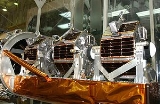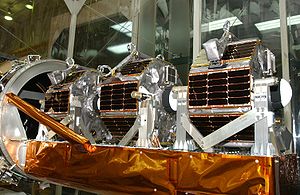
Miniaturized satellite
Encyclopedia
Miniaturized satellites or small satellites are artificial satellites of unusually low weights and small sizes, usually under 500 kg (1,102.3 lb). While all such satellites can be referred to as small satellites, different classifications are used to categorize them based on mass (see below).
One reason for miniaturizing satellites is to reduce the cost: heavier satellites require larger rockets of greater cost to finance; smaller and lighter satellites require smaller and cheaper launch vehicles and can sometimes be launched in multiples. They can also be launched 'piggyback', using excess capacity on larger launch vehicles. Miniaturized satellites allow for cheaper designs as well as ease of mass production, although few satellites of any size other than 'communications constellations' where dozens of satellites are used to cover the globe, have been mass produced in practice.
Besides the cost issue, the main rationale for the use of miniaturized satellites is the opportunity to enable missions that a larger satellite could not accomplish, such as:

Except the mass, the size of satellite is important too.
series of microsatellites) is usually applied to the name of an artificial satellite with a wet mass between 0.1 kilogram. Again designs and proposed designs of these types usually have multiple picosatellites working together or in formation (sometimes the term "swarm" is applied). Some designs require a larger "mother" satellite for communication with ground controllers or for launching and docking with picosatellites. The CubeSat
design, with 1 kg maximum mass, is an example of a large picosatellite (or minimum nanosat).
Larger satellites usually use monopropellant
s or bipropellant combustion
rockets
for propulsion and attitude control; these systems are complex and require a minimal amount of volume to surface area to dissipate heat. These systems are used on larger microsats, while other micro/nanosats have to use electric propulsion, compressed gas, vaporizable liquids such as butane
or carbon dioxide
or other innovative propulsion systems that are simple, cheap and scalable.
Microsats can use conventional radio systems in UHF, VHF, the S-band and X-band, although often miniaturized using more up-to-date technology as compared to larger satellites. Tiny satellites such as nanosats and small microsats may lack the power supply or mass for large conventional radio transponders, and various miniaturized or innovative communications systems have been proposed, such a laser receivers, antenna arrays and satellite to satellite communication networks. Few of these have been demonstrated in practice.
Electronics need to be rigorously tested and modified to be "space hardened" or resistant to the outer space environment (vacuum, microgravity, thermal extremes, and radiation exposure). Miniaturized satellites allow for the opportunity to test new hardware with reduced expense in testing. Furthermore, since the overall cost risk in the mission is much lower, more up-to-date but less space-proven technology can be incorporated into micro and nanosats than can be used in much larger, more expensive missions with less appetite for risk.
Manufacturers of microsatellites include SpaceDev
and Surrey Satellite Technology Ltd
.
Manufacturers of nanosatellites include GomSpace, ISIS and UTIAS-SFL.
SuitSat
, a retired spacesuit fitted with some basic instrumentation and radio transmitting equipment and released into orbit in 2006, was an unconventional example of a low-cost microsatellite test platform.
One reason for miniaturizing satellites is to reduce the cost: heavier satellites require larger rockets of greater cost to finance; smaller and lighter satellites require smaller and cheaper launch vehicles and can sometimes be launched in multiples. They can also be launched 'piggyback', using excess capacity on larger launch vehicles. Miniaturized satellites allow for cheaper designs as well as ease of mass production, although few satellites of any size other than 'communications constellations' where dozens of satellites are used to cover the globe, have been mass produced in practice.
Besides the cost issue, the main rationale for the use of miniaturized satellites is the opportunity to enable missions that a larger satellite could not accomplish, such as:
- Constellations for low data rate communications
- Using formations to gather data from multiple points
- In-orbit inspection of larger satellites.
Classification groups

Minisatellite
The term "minisatellite" usually refers to an artificial satellite with a "wet mass" (including fuel) between 100 kilogram, though these are usually simply called "small satellites". Minisatellites are usually simpler but use the same technologies as larger satellites.Microsatellite
Microsatellite or "microsat" is usually applied to the name of an artificial satellite with a wet mass between 10 kilogram. However, this is not an official convention and sometimes microsats can refer to satellites larger than that. Sometimes designs or proposed designs of these types have microsatellites working together or in a formation. The generic term "small satellite" is also sometimes used.Except the mass, the size of satellite is important too.
Nanosatellite
The term "nanosatellite" or "nanosat" is usually applied to an artificial satellite with a wet mass between 1 kilogram. Again designs and proposed designs of these types usually have multiple nanosatellites working together or in formation (sometimes the term "swarm" is applied). Some designs require a larger "mother" satellite for communication with ground controllers or for launching and docking with nanosatellites.Picosatellite
Picosatellite or "picosat" (not to be confused with the PicoSATPicoSAT
PicoSAT, launched on September 30, 2001, is a real time tracking satellite picosatellite of the miniaturized satellite series. The name "PICO" combines the first letters of all four of its experiments . PICOSat series are designed for a minimum of one year of on-orbit operations. The name Picosat...
series of microsatellites) is usually applied to the name of an artificial satellite with a wet mass between 0.1 kilogram. Again designs and proposed designs of these types usually have multiple picosatellites working together or in formation (sometimes the term "swarm" is applied). Some designs require a larger "mother" satellite for communication with ground controllers or for launching and docking with picosatellites. The CubeSat
CubeSat
A CubeSat is a type of miniaturized satellite for space research that usually has a volume of exactly one liter , has a mass of no more than 1.33 kilograms, and typically uses commercial off-the-shelf electronics components...
design, with 1 kg maximum mass, is an example of a large picosatellite (or minimum nanosat).
Technical challenges
Micro/nanosats usually require innovative propulsion, attitude control, communication and computation systems.Larger satellites usually use monopropellant
Monopropellant
Monopropellants are propellants composed of chemicals or mixtures of chemicals which can be stored in a single container with some degree of safety. While stable under defined storage conditions, they react very rapidly under certain other conditions to produce a large volume of energetic gases...
s or bipropellant combustion
Combustion
Combustion or burning is the sequence of exothermic chemical reactions between a fuel and an oxidant accompanied by the production of heat and conversion of chemical species. The release of heat can result in the production of light in the form of either glowing or a flame...
rockets
Rocket
A rocket is a missile, spacecraft, aircraft or other vehicle which obtains thrust from a rocket engine. In all rockets, the exhaust is formed entirely from propellants carried within the rocket before use. Rocket engines work by action and reaction...
for propulsion and attitude control; these systems are complex and require a minimal amount of volume to surface area to dissipate heat. These systems are used on larger microsats, while other micro/nanosats have to use electric propulsion, compressed gas, vaporizable liquids such as butane
Butane
Butane is a gas with the formula C4H10 that is an alkane with four carbon atoms. The term may refer to any of two structural isomers, or to a mixture of them: in the IUPAC nomenclature, however, butane refers only to the unbranched n-butane isomer; the other one being called "methylpropane" or...
or carbon dioxide
Carbon dioxide
Carbon dioxide is a naturally occurring chemical compound composed of two oxygen atoms covalently bonded to a single carbon atom...
or other innovative propulsion systems that are simple, cheap and scalable.
Microsats can use conventional radio systems in UHF, VHF, the S-band and X-band, although often miniaturized using more up-to-date technology as compared to larger satellites. Tiny satellites such as nanosats and small microsats may lack the power supply or mass for large conventional radio transponders, and various miniaturized or innovative communications systems have been proposed, such a laser receivers, antenna arrays and satellite to satellite communication networks. Few of these have been demonstrated in practice.
Electronics need to be rigorously tested and modified to be "space hardened" or resistant to the outer space environment (vacuum, microgravity, thermal extremes, and radiation exposure). Miniaturized satellites allow for the opportunity to test new hardware with reduced expense in testing. Furthermore, since the overall cost risk in the mission is much lower, more up-to-date but less space-proven technology can be incorporated into micro and nanosats than can be used in much larger, more expensive missions with less appetite for risk.
Manufacturers of microsatellites include SpaceDev
SpaceDev
SpaceDev, a part of the "Space Systems Business" of Sierra Nevada Corporation, is prominent for its spaceflight and microsatellite work. It designed and built the hybrid rocket motors for Paul Allen's Tier One suborbital SpaceShipOne space program operated by Scaled Composites...
and Surrey Satellite Technology Ltd
Surrey Satellite Technology Ltd
Surrey Satellite Technology Ltd, or SSTL, is a spin-off company of the University of Surrey, now fully owned by EADS Astrium, that builds and operates small satellites. Its satellites began as amateur radio satellites known by the UoSAT name or by an OSCAR designation...
.
Manufacturers of nanosatellites include GomSpace, ISIS and UTIAS-SFL.
SuitSat
SuitSat
SuitSat is a retired Russian Orlan spacesuit with a radio transmitter mounted on its helmet. SuitSat-1 was deployed in an ephemeral orbit around the Earth on February 3, 2006...
, a retired spacesuit fitted with some basic instrumentation and radio transmitting equipment and released into orbit in 2006, was an unconventional example of a low-cost microsatellite test platform.
See also
- Canadian Advanced Nanospace eXperiment ProgramCanadian Advanced Nanospace eXperiment ProgramThe Canadian Advanced Nanospace eXperiment program is the only Canadian nanosatellite program at present. It is operated by the University of Toronto Institute for Aerospace Studies, Space Flight Laboratory...
- CanSatCanSatA CanSat is a type of miniaturized satellite. In CanSat competitions, it's required to fit inside of a soda can and have a mass below 350g. Antennas can be mounted externally, but the diameter can't increase until the CanSat has left the launch vehicle. The CanSats are deployed from small rocket...
- DRAGONSatDRAGONSatDRAGONSat DRAGONSat DRAGONSat (Dual RF Astrodynamic GPS Orbital Navigator Satellite is a pair of picosatellites that will be demonstrating autonomous rendezvous and docking (ARD) in low Earth orbit (LEO) for NASA. It will be gathering flight data with a global positioning system (GPS) receiver...
picosatellite - Micro air vehicleMicro air vehicleA micro air vehicle , or micro aerial vehicle , is a class of unmanned aerial vehicles that has a size restriction and may be autonomous. Modern craft can be as small as 15 centimetres...
- N-prizeN-PrizeThe N-Prize is a competition to stimulate innovation directed towards obtaining cheap access to space. The competition was launched in 2008 by Cambridge biologist Paul H...
- Nanosatellite Launch SystemNanosatellite Launch SystemThe Nanosatellite Launch System is a series of satellite launch missions coordinated by the Space Flight Laboratory of the University of Toronto Institute for Aerospace Studies...
- Satellite formation flyingSatellite formation flyingSatellite formation flying is the concept that multiple satellites can work together in a group to accomplish the objective of one larger, usually more expensive, satellite...
- SPHERESSPHERESThe Synchronized Position Hold, Engage, Reorient Experimental Satellites experiment is a testbed consisting of three miniaturized satellites that can operate in a variety of environments, including inside the International Space Station...
- Student Space Exploration & Technology InitiativeStudent Space Exploration & Technology InitiativeThe Student Space Exploration & Technology Initiative is a unique project put into execution by students from different universities spread over European countries...
- University Nanosat Program
External links
- Edusat Project
- http://marsnet.jpl.nasa.gov/index.html
- http://www.accessscience.com/ResUpdates/2004/YB_041170_frameset.html?doi
- Teich's Tech Tidbit of the Week December 13, 1999 Nanosats

